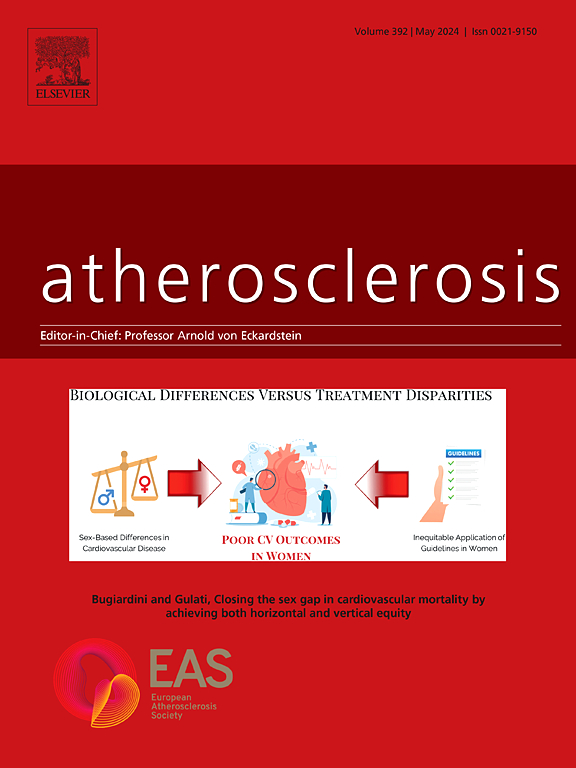Enhanced coronary physiology assessment with endothelial shear stress predicts residual cardiovascular risk in older patients with myocardial infarction
IF 5.7
2区 医学
Q1 CARDIAC & CARDIOVASCULAR SYSTEMS
引用次数: 0
Abstract
Background
The relationship between traditional risk factors, translesional hemodynamics, and plaque vulnerability remains incompletely understood. Endothelial shear stress (ESS) has recently emerged among the key players determining lesions instability and cardiovascular risk.
Aims
We aimed to evaluate the prognostic value of ESS-based quantities and their interplay with anatomical and clinical factors in predicting adverse cardiovascular events in older patients with multivessel coronary artery disease (MVD).
Methods
This post hoc analysis of the Functional Assessment in Elderly MI Patients with Multivessel Disease (FIRE) trial included older patients (≥75 years) with acute myocardial infarction (MI) and MVD undergoing percutaneous coronary intervention (PCI). ESS was assessed by angiography-based computational fluid dynamics simulations and the topological shear variation index (TSVI), recently emerged as predictor of future MI measurable within a clinical framework, was computed in non-culprit coronary lesions with negative functional assessment left untreated. The primary endpoint was major adverse cardiovascular events (MACE) at one year, defined as a composite of all-cause death, non-fatal MI, stroke, and ischemia-driven revascularization. Multivariate Cox regression and causal inference analysis were used to assess the prognostic role of anatomo-functional metrics alongside traditional risk factors.
Results
A total of 335 FIRE trial patients were analyzed. The median percentage area stenosis (%AS), lesion length, time-averaged ESS, and TSVI were 57.2 %, 12.3 mm, 2.9 Pa, and 59.2 m-1, respectively. Severe lesions were associated with a higher risk of the primary outcome (hazard ratio, HR, 1.024, 95 % confidence interval, CI, 1.002–1.046, p = 0.031). Longer lesions were significantly linked to an increased risk of all-cause death (HR 1.042, 95 % CI 1.009–1.077, p = 0.013), while TSVI was associated with higher risk of MI (HR 1.006, 95 % CI 1.000–1.012, p = 0.014) and ischemia-driven revascularization (HR 1.006, 95 % CI 1.000–1.012, p = 0.021). The inclusion of %AS, lesion length, and TSVI significantly improved multivariate outcome prediction. Causal inference analysis indicated that TSVI had a strong causal association with both MI and revascularization, with an information content at least equal to that of %AS.
Conclusions
TSVI, rather than absolute ESS magnitude, plays a key role in predicting acute events in older MI patients with MVD. Integrating ESS-based factors with traditional clinical and anatomical factors significantly enhances risk prediction and helps refine management strategies for this challenging patient population.

增强冠状动脉生理学评估与内皮剪切应力预测老年心肌梗死患者剩余心血管风险
传统的危险因素、经性病变血流动力学和斑块易损性之间的关系尚不完全清楚。内皮剪切应力(ESS)最近出现在决定病变不稳定性和心血管风险的关键因素中。目的:我们旨在评估基于ess的数量及其与解剖学和临床因素的相互作用在预测老年多支冠状动脉疾病(MVD)患者不良心血管事件中的预后价值。方法对老年心肌梗死合并多血管疾病(FIRE)患者的功能评估(post - hoc analysis)试验纳入了老年(≥75岁)合并急性心肌梗死(MI)和MVD的经皮冠状动脉介入治疗(PCI)患者。ESS通过基于血管造影的计算流体动力学模拟进行评估,拓扑剪切变异指数(TSVI)最近被认为是在临床框架内可测量的未来心肌梗死的预测指标,在非罪魁祸首冠状动脉病变中,未经治疗的功能评估为阴性。主要终点是一年内的主要不良心血管事件(MACE),定义为全因死亡、非致死性心肌梗死、卒中和缺血驱动的血运重建的复合。采用多变量Cox回归和因果推理分析来评估解剖功能指标与传统危险因素的预后作用。结果共分析了335例FIRE试验患者。中位狭窄面积百分比(%AS)、病变长度、时间平均ESS和TSVI分别为57.2%、12.3 mm、2.9 Pa和59.2 m-1。严重病变与较高的主要结局风险相关(风险比,HR, 1.024, 95%可信区间,CI, 1.002-1.046, p = 0.031)。较长的病变与全因死亡风险增加显著相关(HR 1.042, 95% CI 1.009-1.077, p = 0.013),而TSVI与心肌梗死(HR 1.006, 95% CI 1.000-1.012, p = 0.014)和缺血驱动的血流量重建(HR 1.006, 95% CI 1.000-1.012, p = 0.021)的高风险相关。纳入%AS、病变长度和TSVI显著改善了多变量预后预测。因果推理分析表明,TSVI与心肌梗死和血运重建均有较强的因果关系,其信息量至少等于%AS。结论svi在预测老年心肌梗死合并MVD的急性事件中起关键作用,而非ESS的绝对大小。将基于ess的因素与传统的临床和解剖学因素相结合,可以显著提高风险预测,并有助于改进这一具有挑战性的患者群体的管理策略。
本文章由计算机程序翻译,如有差异,请以英文原文为准。
求助全文
约1分钟内获得全文
求助全文
来源期刊

Atherosclerosis
医学-外周血管病
CiteScore
9.80
自引率
3.80%
发文量
1269
审稿时长
36 days
期刊介绍:
Atherosclerosis has an open access mirror journal Atherosclerosis: X, sharing the same aims and scope, editorial team, submission system and rigorous peer review.
Atherosclerosis brings together, from all sources, papers concerned with investigation on atherosclerosis, its risk factors and clinical manifestations. Atherosclerosis covers basic and translational, clinical and population research approaches to arterial and vascular biology and disease, as well as their risk factors including: disturbances of lipid and lipoprotein metabolism, diabetes and hypertension, thrombosis, and inflammation. The Editors are interested in original or review papers dealing with the pathogenesis, environmental, genetic and epigenetic basis, diagnosis or treatment of atherosclerosis and related diseases as well as their risk factors.
 求助内容:
求助内容: 应助结果提醒方式:
应助结果提醒方式:


